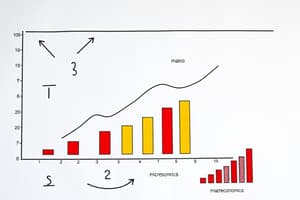Podcast
Questions and Answers
What fundamental forces of the market determine the price and quantity of goods and services in microeconomics?
What fundamental forces of the market determine the price and quantity of goods and services in microeconomics?
Supply and Demand
Explain the concept of efficiency in microeconomics.
Explain the concept of efficiency in microeconomics.
Resources are allocated in a manner that maximizes the satisfaction of consumers' needs.
What influences consumer choice in microeconomics?
What influences consumer choice in microeconomics?
Factors like price, income, and the availability of goods.
Define the term 'Production and Cost' in microeconomics.
Define the term 'Production and Cost' in microeconomics.
What economic units does macroeconomics focus on?
What economic units does macroeconomics focus on?
Define GDP and explain its significance in the study of macroeconomics.
Define GDP and explain its significance in the study of macroeconomics.
How does unemployment impact the economy, and why is it a crucial topic in macroeconomics?
How does unemployment impact the economy, and why is it a crucial topic in macroeconomics?
Explain the concept of inflation and its effects on the economy.
Explain the concept of inflation and its effects on the economy.
How do interest rates function as a tool for central banks to control inflation?
How do interest rates function as a tool for central banks to control inflation?
Discuss the interconnectedness between microeconomics and macroeconomics with a specific example.
Discuss the interconnectedness between microeconomics and macroeconomics with a specific example.
Flashcards are hidden until you start studying
Study Notes
Understanding Economics: Micro and Macro Perspectives
Economics is a discipline that examines the production, distribution, exchange, and consumption of goods and services, as well as the behavior of individuals, organizations, and governments in making decisions. This study is divided into two primary branches: microeconomics and macroeconomics.
Microeconomics
Microeconomics delves into the individual and small-scale economic interactions, focusing on the behavior of individual consumers, producers, and businesses. Key concepts in microeconomics include:
- Supply and Demand: Two fundamental forces of the market that determine the price and quantity of goods and services.
- Efficiency: The concept that resources are allocated in a manner that maximizes the satisfaction of consumers' needs.
- Consumer Choice: The decisions individuals make to satisfy their wants and needs, influenced by factors like price, income, and the availability of goods.
- Production and Cost: The processes by which businesses produce goods and services, as well as the expenses incurred, such as labor, materials, and overhead.
Macroeconomics
In contrast, macroeconomics takes a macroscopic view, considering the behavior of large economic units, such as entire countries, regions, or sectors. This branch of economics focuses on the performance of the economy as a whole and studies the following key topics:
- Gross Domestic Product (GDP): The total monetary value of all final goods and services produced within a country's borders in a specific time period.
- Unemployment: The percentage of the labor force without jobs, which can affect economic output and the overall well-being of a society.
- Inflation: The persistent increase in the general level of prices for goods and services, measured by the Consumer Price Index (CPI).
- Interest Rates: The rates at which borrowers can obtain money and lenders can earn returns on their investments. Interest rates are a tool used by central banks to control inflation and stabilize economies.
Interconnectedness of Micro and Macroeconomics
Although these two branches of economics address different economic scales, they are inherently interconnected. For example, changes in interest rates, which are determined by macroeconomic policies, can affect individual borrowing and lending decisions. Similarly, individual consumer spending decisions can influence the overall demand and, consequently, the macroeconomic indicators like GDP and inflation.
Final Thoughts
While both microeconomics and macroeconomics are essential components of the study of economics, each offers unique insights and perspectives into the complexities of economic behavior. Understanding these subfields is essential to comprehending economic dynamics at work and developing well-informed opinions on economic matters. Armed with this knowledge, you can now make more informed decisions about your personal finances and contribute to broader discussions about national and global economic trends.
Studying That Suits You
Use AI to generate personalized quizzes and flashcards to suit your learning preferences.




